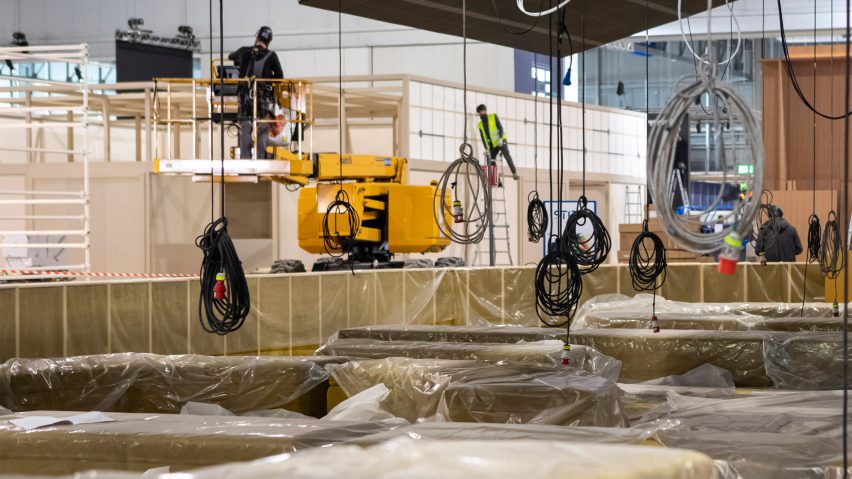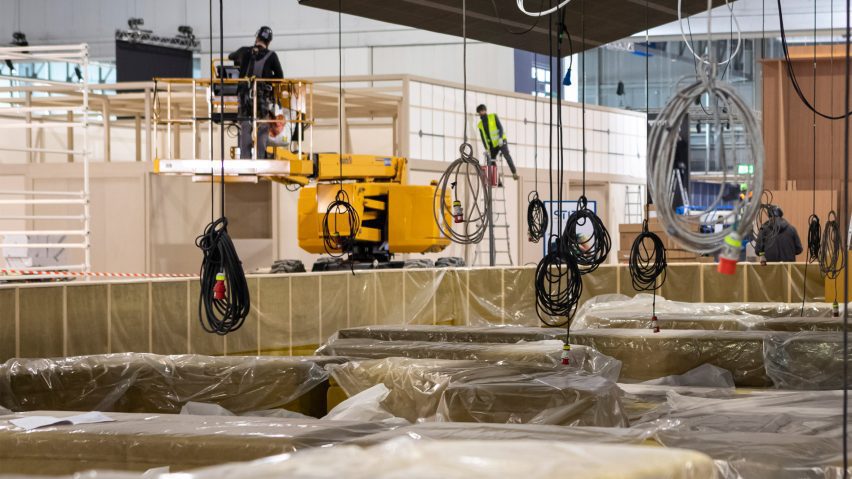“No hiding” from environmental impact of trade fairs say designers at Salone
More work is needed to improve the sustainability of trade fairs like Salone del Mobile, designers told Dezeen at Milan design week.
British designer Tom Dixon warned it could take a decade for brands to transform their operations at events like Salone in order to reduce emissions and resource consumption.
“It’s a lot of people coming from all over the world – it’s a lot of carbon footprint just embedded in the flights,” he said. “I think we’ve got to rethink completely how we show [products], where we make them, where we transport them to, and the rest of it, but that’s a project which is a 10-year project.”
Need “to rethink completely” how products are showcased
Norm Architects’ Frederik Werner, in Milan to exhibit a collaboration with Japanese furniture maker Karimoku, suggested that fewer trade fairs should take place during the year to cut the carbon cost.
“I think for the setup of the fair itself there’s no hiding from it, it’s kind of crazy how much is being produced and built, and that’s just the reality right now,” he said.
“I think probably the main issue is that there’s so many venues around the world doing the same, with things being shipped around. It somehow makes sense to create one hub for it to happen.”

Salone del Mobile was held in Milan last week, back in its conventional April slot for the first time in four years following covid disruptions.
It is the world’s biggest design fair and forms the trade centrepiece of Milan design week.
The organisers have sought to improve the sustainability of the event in recent years, signing up to the UN Global Compact corporate sustainability pledge for 2023 and updating voluntary guidelines for exhibitors.
In an interview prior to the event, Salone president Maria Porro told Dezeen that the fair has tried to use recycled and recyclable materials and work with organisations committed to caring for the planet.
But with 2,000 brands showing their products at the week-long show and around 400,000 visitors expected, mostly from overseas, some remain concerned about Salone’s environmental impact, including Dezeen columnist Katie Treggiden.
“We’re all part of it, as we flew to Milan”
“We can’t walk around the city, gelato in hand, and pretend that almost 2,000 international brands haven’t shipped or air-freighted their wares into the Rho Fiera Milano fairgrounds,” Treggiden wrote in a recent piece.
Dutch designer Maarten Baas deliberately referenced the contradiction of promoting more sustainable designs by flying them to Milan in a collaboration with fashion label G-Star RAW.
His More or Less exhibition for the brand features a private jet wrapped in denim.
“Each year in Milan, I enjoy the tragicomic dialogue between green design and mass consumption,” he told Dezeen.
“We’re all part of it, as we flew to Milan to enjoy our prosecco next to some works of recycled materials.”

Nevertheless, designers argued there is still a value to large-scale physical events like Salone.
“Airplanes aren’t sustainable but I think people coming to see art and people coming to see new ideas is always a benefit to society,” said Santiago Brown of New York-based Forma Rosa Studio.
“The issue is transportation, but it’s super important for people to see art and not just on Instagram.”
“In this digital era you can see everything online but, especially with materials when it’s about the haptic, the touch, the interaction, you come to a better understanding of the research project when you see it with your eyes, when someone talks to you about it,” added Crafting Plastics’ Vlasta Kubušová.
“So for me, it still makes sense to do this once a year I think, even if we have to travel – and we always will travel.”
Studios and brands try to use less materials
Jussi Laine of Nemo Architects, who designed the Habitarematerials installation at Milan design exhibition Alcova, said he is “absolutely” concerned about the environmental impact of Salone.
He said it was important for designers travelling to Milan to use it as an opportunity to learn about how to make their work more sustainable.
“Design shows are a way to pass information and knowledge,” he told Dezeen. “It is really up to us how relevant the message is, and also up to us how we receive that information and act upon it.”
Brands and designers have attempted to improve the sustainability of their activities in Milan, especially by planning for the re-use of materials.
“For this year’s fair we’ve tried to work with systems and patterns that we can reuse for next year, so all the louvres and lamellas can be stored and put away again,” said Werner.
“Half of the furniture collection I think might be taken to our next exhibition instead of being shipped back to Japan.”
“Our booth is made out of storage racks that we took from our own storage,” Mexico-based David Pompa told Dezeen.
“So we took them, we built them down, we build them up here and we’re going to build them up again in our storage after the exhibition. So we’re not throwing away anything.”
However, Dixon admitted it was still “difficult to claim total sustainability”.
“We’ll reuse a lot of this stuff,” he said. “I’m sure a lot of people are thinking about how they can do that.”
“But it’s difficult to claim total sustainability in the context of fairs, I’m not going to try and greenwash you on this one.”
Milan itself is frequently ranked among Europe’s most polluted cities, though it is working on an ambitious project to construct 750 kilometres of bike lanes by 2035 as part of a strategy to become net-zero by 2050.
Additional reporting by Cajsa Carlson and Jennifer Hahn. The photography is courtesy of Salone del Mobile.
Salone del Mobile 2023 took place from 18 to 23 April at the Fiera Milano exhibition centre, Italy. See Dezeen Events Guide for an up-to-date list of architecture and design events taking place around the world.



